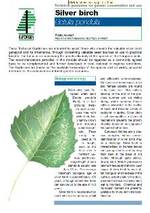Betula pendula - Technical guidelines for genetic conservation and use for silver birch
This publication has been translated into the following languages:
Polish Slovenian
Because silver birch is a widespread species, the environmental conditions and hence priority and methodology of genetic conservation are different in various parts of the distribution area. In northern Eu- rope silver birch is common and has almost continuous distribution over large areas without any immediate threats to the amount of genetic diversity, hence the nature of the gene conservation measures in these areas is mostly precautionary. These measures include restrictions on the use of single seed sources or vegetatively reproduced clones and the selection of properly adapted forest reproductive material.
In the northern parts of the distribution area (Finland and Sweden), controlling the distance of provenance shifts is crucial for the successful use of planting material. In order to avoid the risk of late spring and early autumn frosts, the recommended maximum transfer distance in Finland is 150km either north or south. The transfer distance could be larger at low elevations in Central European countries.
An additional measure to protect the natural genetic composition is to select in situ areas for genetic conservation either for birch alone or as mixed forest with other species. Such areas can be nature conservation areas or gene reserve forests under commercial forestry. In both cases natural regeneration should be favoured or, if artificial regeneration must be applied, the material originating from the same forest should be used.
In the areas of scattered distribution the use of gene reserve forests may not be possible. The local stands may be too small and threatened by various environmental hazards to such a degree that an ex situ conservation strategy is more applicable. Ex situ collections may be based on either grafts or seedlings.
A special case for gene conservation is curly birch, which is usually found as single trees or as groups of a few trees in natural forests. In such cases a population-based approach is not functional and an ex situ collection of individual clones (genotypes) is a more appropriate approach. The collections can be created either by grafting or seedlings.
Authors: Pekka Vakkari
Journal/Series:
EUFORGEN Technical Guidelines for Genetic Conservation and Use
Publication Year: 2009
Publication Format: PDF
ISBN 13: 978-92-9043-803-8
Language: EN
Pages: 6 P.
Technical guidelines Betula pendula

